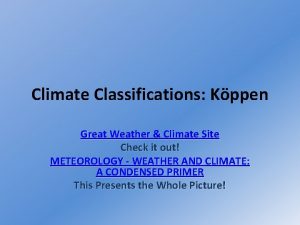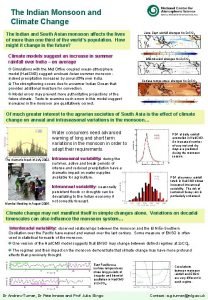The Indian Monsoon and Climate Change The Indian


- Slides: 2

The Indian Monsoon and Climate Change The Indian and South Asian monsoon affects the lives of more than one third of the world’s population. How might it change in the future? Climate models suggest an increase in summer rainfall over India – on average Simulations with the Met Office coupled ocean-atmosphere model (Had. CM 3) suggest a robust Asian summer monsoon - indeed precipitation increases by around 5% over India. The strengthening occurs due to a warmer Indian Ocean that provides additional moisture for convection. Model errors may prevent more authoritative projections of the future climate. Tests to examine such errors in this model suggest increases in the monsoon are qualitatively correct. June-Sept rainfall changes for 2 x. CO 2 850 mb wind changes for 2 x. CO 2 Surface temperature changes for 2 x. CO 2 Of much greater interest to the agrarian societies of South Asia is the effect of climate change on annual and intraseasonal variations in the monsoon… Water consumers need advanced warning of long and short term variations in the monsoon in order to adapt their requirements. The dramatic break of July 2002. Intraseasonal variability: during the summer, active and break periods of intense and reduced precipitation have a dramatic impact on water supplies available for agriculture. Interannual variability: seasonally Mumbai flooding in August 2005. persistent floods or droughts can be devastating to the Indian economy if not correctly forecast. PDF of daily rainfall anomalies in Had. CM 3. An increased number of very wet and dry days are predicted during the monsoon season. PDF of summer rainfall totals in Had. CM 3 shows increased interannual variability. The risk of sustained heavy rain is particularly enhanced. Climate change may not manifest itself in simple changes alone. Variations on decadal timescales can also influence the monsoon system… Interdecadal variability: observed relationships between the monsoon and the El Niño-Southern Oscillation over the Pacific have waxed and waned over the last century. Some measure of ENSO is often used in statistical forecasts of the monsoon. One version of the Had. CM 3 model suggests that ENSO may change between distinct regimes at 2 x. CO 2. The regimes and their impact on the monsoon demonstrate that climate change may have more profound effects than previously thought. East Pacific seasurface temperatures show long periods of irregular and biennial oscillation in Had. CM 3 at 2 x. CO 2. Dr Andrew Turner, Dr Pete Inness and Prof Julia Slingo Correlations between monsoon rainfall and ENSO are very different in each regime. Contact: a. g. turner@rdg. ac. uk

• • • Global warming and climate change is one of the most extensively researched and discussed topical issues affecting the environment. Although there are enough historical evidence to support theory that climate change is a natural phenomenon, many research scientists are widely in agreement that the increase in temperature in the 20 th century is anthropologically related. The associated effects are the variability of rainfall and cyclonic patterns that are being observed globally. In Southeast Asia the link between global warming and the seasonal atmospheric flow during the monsoon seasons shows varying degree of fuzziness. This study investigates the impact of climate change on the seasonality of monsoon Asia and its effect on the variability of monsoon rainfall in Southeast Asia. The comparison of decadal variation of precipitation and temperature anomalies before the 1970 s found general increases which were mostly varying. But beyond the 1970 s, global precipitation anomalous showed increases that almost corresponded with increases in global temperature anomalies for the same period. There are frequent changes and a shift westward of the Indian summer monsoon. Although precipitation is observed to be 70% below normal levels, in some areas the topography affects the intensity of rainfall. These shifting phenomenon of other monsoon season in the region are impacting on the variability of rainfall and the onset of monsoons in Southeast Asia and is predicted to delay for 15 days the onset of the monsoon in the future. The variability of monsoon rainfall in the SEA region is observed to be decadal and the frequency and intensity of intermittent flooding of some areas during the monsoon season have serious consequences on the human, financial, infrastructure and food security of the region. Schewe and Levermann (2012) predicted the increasing temperature in the late 21 st century and early 22 nd century will cause frequent changes and shifts to the monsoon precipitation up to 70% below normal levels. Not only will this affect the Indian summer monsoon, but the onset of monsoon over Southeast Asia may also be delayed up to 15 days



